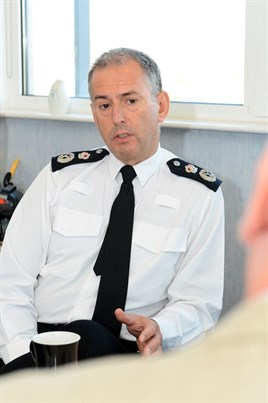“With the heightened threat, there’s a lot to be done around visibility of our officers and resources to deter an attack. We have upped the number of armed patrols.”
Firearms training has been taken in-house, rather than hiring other police forces. Crowther says it is cheaper for the BTP to use its own firearms officers as trainers. He does not say how many officers routinely carry weapons.
“We have seen an increase in bomb threats. We are still assessing 20 to 30 bomb threats to the railway every month. We apply a very sophisticated analysis to those threats. Over the last ten years, despite hundreds of bomb threats, we have not once recommended that the railway has closed.
“We know that the cost of closing a major hub is about £2m a time. So every time we assess a threat, we know we can save the industry lots of money and save the public lots of disruption. We need access to all the advice, the security agencies, the intelligence that enables us to make those decisions.”
Is the terrorism threat on the railway as London-centric as the policing? Crowther says much of it is, because the biggest crowds and the most obvious targets are in the capital. But looking at the pattern of terrorist attacks over the last century, he says there are more incidents on the transport network than anywhere else.
“In many ways, the more target-hardened London is, the greater the temptation for people intent on doing this sort of thing to move outside London.”
Suicides
The railway remains extremely sensitive about the issue of suicides. In the wake of economic recession, the number of people choosing to end their lives under a train has increased sharply.
Train operators are unwilling to discuss the subject, fearing increased awareness will further encourage suicides. But Network Rail has had notable success in the last year and its work with the Samaritans has been widely praised.
Crowther leads police work nationally on suicide prevention. It’s a subject he believes would benefit from greater sensitive public debate, although he concedes it remains difficult and complex. It is in this area that he becomes most animated, enthusiastic and demonstrative.
“We do a great deal of analysis. We look at the distribution of fatalities. We look at where people live and where the incidents take place - how far they travel to kill themselves.
“In London, Ealing has a high suicide incidence. There is over-representation of a particular cultural group there, and most people who take their own lives in Ealing also live locally.
“Contrast that with Camden and Islington NHS Foundation Trust area - the highest level of sectioning under the Mental Health Act in the UK. The average distance travelled for a suicide is 65 miles, but in Camden and Islington it is 165 miles. This is a catchment area that includes Euston, King’s Cross and St Pancras.
“There was an inward health problem from people who were not local. And nothing was being done about it. It was a “light bulb” moment. The NHS, Network Rail and London Underground gave us some money. We set up a street triage project, with mental health nurses now working alongside police officers.
“The result: across the force we’ve seen a 10% rise in suicides during the pilot period. In the area where we are doing street triage, we’re seeing a 14% reduction. This is groundbreaking stuff. And besides our obvious desire to save a life, we know how much it costs the railway in time and money each time there is a fatality.”
Crowther explains that his intelligence unit searches fatalities through social media sites, including checking contacts on Facebook. By reading the comments on the pages of people who have been bereaved, they have identified what he calls a “tribute element” by others who may attempt similar suicide at the same location. They then put these vulnerable people in touch with doctors, mental health teams and the Samaritans.
“We may not always be visible on this, but our tentacles are out there, doing really innovative things.”
“Our response units in north London each attend about 12 fatalities a year, and these are very unpleasant for our staff to deal with. There is a danger of sounding clichéd here, but I see how we make a difference. We are genuinely saving two or three lives every day. My people go onto the tracks, and they drag people off before a train mows them down. Every day.
“I’m waiting to talk to some officers now. The night before last was the latest in many incidents where someone had climbed the parapet of a road bridge to jump. Two officers managed to grab the person as they jumped, holding them for ten minutes, literally holding them, until more help arrived.
“No one wants to talk about this - there is definitely a fear of contagion. You get more people choosing the same location, and nobody wants to take that risk. But it is an issue and we need to talk about it, to get all the right public bodies coming together to deal with it.”
What makes Paul Crowther tick?
Each time he is asked for his own opinion, or prodded for a personal perspective, Paul Crowther sidesteps the opportunity.
Crowther the policeman offers a professional view. Crowther the Chief Constable speaks for his team. Paul, the 53-year-old private individual with a strong London accent, gives nothing away. But he is clearly deeply committed to his employer of the past three and a half decades.
“I’m passionate about this very special organisation that delivers a special type of policing. We are different from other police forces. We have a very strong commercial bent to the things we do, which other forces just wouldn’t even think of doing. I’m very proud of that. “We are introducing some innovative and different things. We keep the network running. That is hugely satisfying.”












